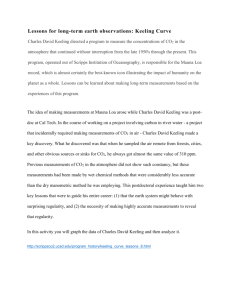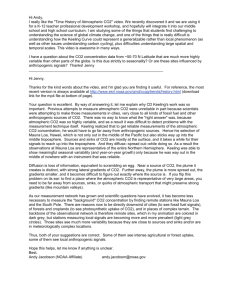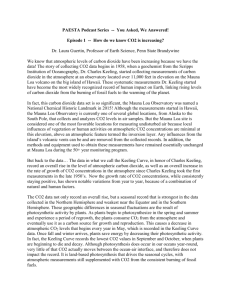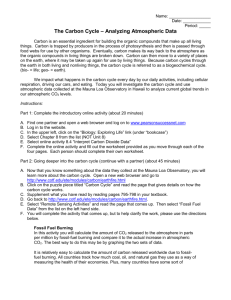docx - MIT Haystack Observatory
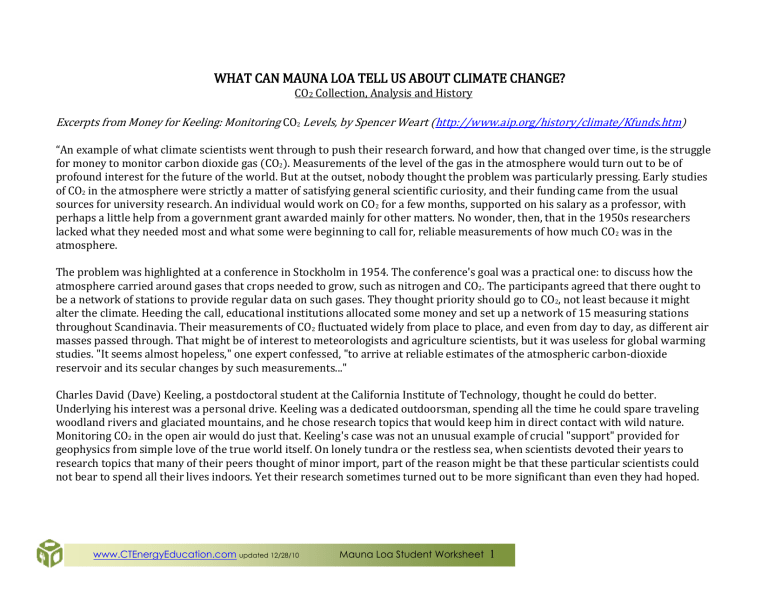
WHAT CAN MAUNA LOA TELL US ABOUT CLIMATE CHANGE?
CO
2
Collection, Analysis and History
Excerpts from Money for Keeling: Monitoring CO
2
Levels, by Spencer Weart ( http://www.aip.org/history/climate/Kfunds.htm
)
“An example of what climate scientists went through to push their research forward, and how that changed over time, is the struggle for money to monitor carbon dioxide gas (CO
2
). Measurements of the level of the gas in the atmosphere would turn out to be of profound interest for the future of the world. But at the outset, nobody thought the problem was particularly pressing. Early studies of CO
2
in the atmosphere were strictly a matter of satisfying general scientific curiosity, and their funding came from the usual sources for university research. An individual would work on CO
2
for a few months, supported on his salary as a professor, with perhaps a little help from a government grant awarded mainly for other matters. No wonder, then, that in the 1950s researchers lacked what they needed most and what some were beginning to call for, reliable measurements of how much CO
2
was in the atmosphere.
The problem was highlighted at a conference in Stockholm in 1954. The conference's goal was a practical one: to discuss how the atmosphere carried around gases that crops needed to grow, such as nitrogen and CO
2
. The participants agreed that there ought to be a network of stations to provide regular data on such gases. They thought priority should go to CO
2
, not least because it might alter the climate. Heeding the call, educational institutions allocated some money and set up a network of 15 measuring stations throughout Scandinavia. Their measurements of CO
2
fluctuated widely from place to place, and even from day to day, as different air masses passed through. That might be of interest to meteorologists and agriculture scientists, but it was useless for global warming studies. "It seems almost hopeless," one expert confessed, "to arrive at reliable estimates of the atmospheric carbon-dioxide reservoir and its secular changes by such measurements..."
Charles David (Dave) Keeling, a postdoctoral student at the California Institute of Technology, thought he could do better.
Underlying his interest was a personal drive. Keeling was a dedicated outdoorsman, spending all the time he could spare traveling woodland rivers and glaciated mountains, and he chose research topics that would keep him in direct contact with wild nature.
Monitoring CO
2
in the open air would do just that. Keeling's case was not an unusual example of crucial "support" provided for geophysics from simple love of the true world itself. On lonely tundra or the restless sea, when scientists devoted their years to research topics that many of their peers thought of minor import, part of the reason might be that these particular scientists could not bear to spend all their lives indoors. Yet their research sometimes turned out to be more significant than even they had hoped. www.CTEnergyEducation.com
updated 12/28/10
Mauna Loa Student Worksheet 1
Just at this time, however, planning was underway for an International Geophysical Year. Scientists and governments organized the
IGY in response to a combination of altruistic and Cold War motives, ranging from a hope to promote international cooperation to a quest for geophysical data of military value. The project would extract a large if temporary lump of new money from the world's governments. Greenhouse gases like CO
2
were too low on the list of IGY concerns to be allocated much support, but with so much money now available, a little might be spared…”
Keeling’s research led to the “Keeling Curve,” a cornerstone of Climate Change science.
“
The “Keeling Curve” of CO
2
measured at Mauna Loa, Hawaii over nearly half a century. Within the long-term rise are annual fluctuations as Northern Hemisphere plants take up carbon during summer growth and release it in winter decay.”
(http://www.aip.org/history/climate/xMaunaLoa.htm) www.CTEnergyEducation.com
updated 12/28/10 http://scrippsco2.ucsd.edu/program_history/keeling_curve_lessons.html
Mauna Loa Student Worksheet 2
How were the Mauna Loa data collected?
Used with permission of Dr. Karen Bice. Original information can be foun at http://www.whoi.edu/science/GG/people/kbice/maunaloa_text.pdf
From Dr. Karen Bice, Woods Hole Oceanographic Institute:
The following description of methodology is modified from the CDIAC web address given above. See the original source for references and more detail.
Methods
The Mauna Loa Observatory, Hawaii, is located near the summit of the active Mauna Loa volcano, 19°32' N, 155°35' W, 3397 m above mean sea level. You can view photos of the facility at http://www.mlo.noaa.gov/. Air samples at Mauna Loa are collected continuously from air intakes at the top of four 7-m towers and one 27-m tower. Four air samples are collected each hour for the purpose of determining the CO
2 concentration. Determinations of CO
2 are made by using a Siemens Ultramat 3 nondispersive infrared gas analyzer with a water vapor freeze trap. This analyzer registers the concentration of CO
2 in a stream of air flowing at
~0.5 L/min. Every 30 minutes, the flow is replaced by a stream of calibrating gas or "working reference gas". In December 1983,
CO
2
-in-N
2
calibration gases were replaced with the currently used CO
2
-in-air calibration gases. These calibration gases and other reference gases are compared periodically to determine the instrument sensitivity and to check for possible contamination in the air-handling system.
Hourly averages of atmospheric CO
2 concentration, wind speed, and wind direction are plotted as a basis for selecting data for further processing. Data are selected for periods of steady hourly data to within ~0.5 parts per million by volume (ppmv); at least six consecutive hours of steady data are required to form a daily average. The Mauna Loa atmospheric CO
2 measurements constitute the longest continuous record of atmospheric CO
2 concentrations available in the world.
The Mauna Loa site is considered one of the most favorable locations for measuring undisturbed air because possible local influences of vegetation or human activities on atmospheric CO
2
concentrations are minimal and any influences from volcanic vents may be excluded from the records. The methods and equipment used to obtain these measurements have remained essentially unchanged during the 46-year monitoring program.
Because of the favorable site location, continuous monitoring, and careful selection and scrutiny of the data, the Mauna Loa record is considered to be a precise record and a reliable indicator of the regional trend in the concentrations of atmospheric CO
2 in the middle layers of the troposphere. www.CTEnergyEducation.com
updated 12/28/10
Mauna Loa Student Worksheet 3
WHAT CAN MAUNA LOA TELL US ABOUT CLIMATE CHANGE?
CO
2
Collection, Analysis and History
Read the excerpt and answer the following questions
1.
How did the focus on CO
2
research change since the 1950’s? (four different changes)
2.
Choose one of your answers from question one and explain why you think that focus from the 1950’s did not support sound scientific research.
3.
The excerpt states that the Keeling Curve shows annual fluctuations (higher and lower shifts) in the CO
2
level at Mauna Loa,
Hawaii (in the Northern Hemisphere.) What causes that fluctuation?
4.
On the following chart, draw a line that represents the cycle of the fluctuations of the CO
2
level at Mauna Loa.
Higher CO
2 level
Lower CO
2 level
spring summer fall winter www.CTEnergyEducation.com
updated 12/28/10
Mauna Loa Student Worksheet 4
WHAT CAN MAUNA LOA TELL US ABOUT CLIMATE CHANGE?
Comparing CO
2
Data by Location
Graph 1 Annual data trends
1.
Graph the 1985, 1990, 1995, 2000 and 2005 annual average data for each location A-F.
2.
Draw a best-fit straight line on the trend of each location.
3.
Look at the line for each location:
Do you see any trends at each location? If so, what?
Do you see any worldwide trends over time? If so, what?
4.
Using the data, what is your projection of what the Average Annual CO
2
level will be at each location in 2007?
Graph 2 Monthly data trends
5.
Graph the monthly data for 1985, 1990, 1995, 2000 and 2005 at each location. Clearly mark the year and location of each line. It is helpful to color key each location. Each location might also be graphed separately.
6.
Assess the shapes of each location’s lines.
Are there locations that seem to have similar shapes?
7.
Discuss the causes of rising or falling CO
2
and what you think might be the cause of changes at each of the graphed locations.
8.
Using the World map worksheet and your knowledge of the causes of the rise and fall of CO
2, decide which of the 6 boxes on the map might be the locations of each of the data sets (A-F) www.CTEnergyEducation.com
updated 12/28/10
Mauna Loa Student Worksheet 5
Location Data:
For each table: Values are taken from a curve consisting of 4 harmonics plus a stiff spline and a linear gain factor, fit to monthly concentration values adjusted to represent 2400 hours on the 15th day of each month. Data used to derive this curve are shown in the accompanying graph. Units are parts per million by volume (ppmv) expressed in the 2003A SIO manometric mole fraction scale. The
"annual average" is the arithmetic mean of the twelve monthly values.
Location A
1985
1990
1995
Jan Feb Mar Apr May Jun Jul Aug Sep Oct Nov Dec Ann. Ave.
342.44 342.60 342.82 342.88 343.17 343.66 343.99 344.26 344.20 343.91 343.91 343.96 343.48
350.58 350.71 350.91 350.96 351.26 351.75 352.09 352.37 352.33 352.03 352.03 352.07 351.59
356.79 356.95 357.18 357.27 357.59 358.12 358.51 358.84 358.84 358.60 358.66 358.76 358.01
2000
2005
365.71 365.85 366.04 366.07 366.34 366.79 367.10 367.34 367.27 366.97 366.96 367.02 366.62
375.01 375.23 375.50 375.65 376.03 376.61 377.04 377.41 377.43 377.21 377.26 377.37 376.48
Location B
1985
1990
1995
2000
2005
Jan
348.37
356.36
362.62
371.59
381.20
Location C
1985
1990
1995
2000
2005
Feb
348.77
356.83
363.13
372.06
381.77
Mar
349.27
357.37
363.73
372.65
382.45
Apr
350.24
358.41
364.86
373.75
383.70
May
350.45
358.64
365.15
373.95
384.05
Jun
348.48
356.59
363.06
371.64
381.80
Jul
344.28
352.22
358.53
366.85
376.93
Aug
340.66
348.45
354.64
362.79
372.76
Sep
341.33
349.20
355.45
363.64
373.70
Oct
344.56
352.61
359.04
367.35
377.67
Nov
347.04
355.24
361.80
370.18
380.75
Dec
348.46
356.75
363.39
371.81
382.56
Ann. Ave.
346.83
354.89
361.28
369.86
379.95
Jan Feb Mar Apr May Jun Jul Aug Sep Oct Nov Dec
350.11 344.04 337.99 338.49 343.09 347.36 350.04
Ann. Ave.
359.12 359.79 360.24 360.45 360.64 358.78 352.52 346.31 346.80 351.51 355.88 358.63 355.89
364.49 365.31 365.88 366.24 366.57 364.80 358.52 352.28 352.87 357.75 362.27 365.12 361.84
373.78 374.58 375.16 375.48 375.77 373.83 367.33 360.97 361.59 366.51 371.05 373.90 370.83
383.23 384.09 384.71 385.10 385.47 383.64 377.11 370.62 371.27 376.38 381.14 384.17 380.58 www.CTEnergyEducation.com
updated 12/28/10
Mauna Loa Student Worksheet 6
Location D
1985
1990
1995
2000
2005
Jan Feb Mar Apr May Jun Jul Aug Sep Oct Nov Dec Ann. Ave.
344.33 344.30 344.07 343.80 343.74 343.91 344.16 344.34 344.45 344.63 344.99 345.42 344.35
352.16 352.15 351.93 351.69 351.66 351.86 352.13 352.32 352.44 352.61 352.95 353.36 352.27
358.86 358.90 358.72 358.51 358.51 358.73 359.00 359.18 359.28 359.44 359.76 360.14 359.09
367.53 367.43 367.11 366.78 366.68 366.82 367.05 367.22 367.33 367.50 367.85 368.27 367.30
376.99 377.04 376.88 376.70 376.75 377.04 377.39 377.68 377.90 378.17 378.61 379.11 377.52
Location E
1985
1990
1995
2000
2005
1985
1990
1995
2000
2005
Location F
Jan Feb Mar Apr May Jun Jul Aug Sep Oct Nov Dec Ann. Ave.
345.99 347.01 347.70 348.71 349.39 348.22 345.53 342.81 341.72 342.82 344.80 346.16 345.91
354.85 355.92 356.62 357.67 358.36 357.20 354.49 351.75 350.67 351.80 353.82 355.20 354.86
361.15 362.21 362.91 363.95 364.64 363.44 360.68 357.91 356.86 358.07 360.19 361.66 361.14
370.05 371.17 371.94 373.04 373.73 372.48 369.65 366.84 365.77 367.00 369.14 370.61 370.12
379.88 381.01 381.77 382.88 383.63 382.40 379.55 376.69 375.63 376.94 379.21 380.80 380.03
Jan Feb Mar Apr May Jun Jul Aug Sep Oct Nov Dec Average
344.97 346.00 347.43 348.35 348.93 348.25 346.56 344.68 343.09 342.80 344.24 345.55 345.90
353.66 354.70 355.39 356.20 357.16 356.23 354.82 352.91 350.96 351.18 352.83 354.21 354.19
359.97 361.00 361.64 363.45 363.79 363.26 361.90 359.46 358.05 357.76 359.56 360.70 360.88
369.14 369.46 370.52 371.66 371.82 371.70 370.12 368.12 366.62 366.73 368.29 369.53 369.48
378.37 379.69 380.41 382.10 382.28 382.13 380.66 378.71 376.42 376.88 378.32 380.04 379.67 www.CTEnergyEducation.com
updated 12/28/10
Mauna Loa Student Worksheet 7
World Map Worksheet
3.
5.
6.
4.
2.
1.
Assign the “CO
2
Collection, Analysis and History” reading excerpt and questions
Answer sheet
1.
How did the focus on CO
2
research change since the 1950’s?
Nobody thought the problem was pressing
Early studies just satisfied scientific curiosity
Funding came from usual sources for university projects
Projects were short-term, a few months
2.
Choose one of your answers from question one and explain why you think that focus from the 1950’s did not support sound scientific research.
No funding if the problem is not “pressing”
No funding to satisfy just “curiosity” and other scientists not actively involved in other parts of the world, supporting the scientific conclusions
Funding more “short term”, and not at levels high enough to support a global effort, or to create the standards and infrastructures needed to make the project an international effort
Data sets to demonstrate global trends take years to develop and must have standardized collection and measurement to be compared to data collected in other locations
3.
The excerpt states that the Keeling Curve shows annual fluctuations (higher and lower shifts) in the CO
2
level at
Mauna Loa, Hawaii (in the Northern Hemisphere.) What causes that fluctuation?
“Plants take up carbon during summer growth and release it in winter decay” www.CTEnergyEducation.com
updated 12/28/10
Mauna Loa Student Worksheet 9
4.
On the following chart, draw a line that represents the cycle of the fluctuations of the CO
2
level at Mauna Loa .
Higher CO
2 level
Lower CO level
2
Spring summer fall winter www.CTEnergyEducation.com
updated 12/28/10
Mauna Loa Student Worksheet 10
Graphing Assignment
The teacher resources material includes the full data sets available for the 6 selected collection sites.
<http://www.ctenergyeducation.com/lesson.htm?id=7gb7b019>
The student assignment worksheets include selected data from 1985, 1990, 1995, 2000 and 2005 for each site. You will want to discuss how to read data sets, and the importance of understanding what the table is telling you.
Recommendations—place students into 6 groups to accomplish each task (the 6 assigned sites) and then compile a classroom data set from all findings.
Graph 1 Annual data trends
Have students graph the 1985, 1990, 1995, 2000 and 2005 annual average data for each location A-F. Locations are indicated on student sheet by letter only.
Have students draw a best-fit straight line on the trend of each location.
Do students note any trends at the particular location? Any worldwide trends over time?
The graphs will show lines trending upward for all locations, rising from the mid-340 unit range to above 380 units.
Using the data, what is your projection of what the Average Annual CO
2
level will be at each location in 2007?
Actual values from data (complete data set): a.
380.43 b.
384.56 c.
384.84 d.
(2006 actual) 379.66 e.
383.86 f.
383.55
As a class discuss what might be projected further into the future (2020 or beyond) How could that value be estimated from this data? What events in the future might change that outcome to be higher or lower? www.CTEnergyEducation.com
updated 12/28/10
Mauna Loa Student Worksheet 11
Graph 2 Monthly data trends
Have students graph the monthly data for 1985, 1990, 1995, 2000 and 2005 at each location. Clearly mark the year and location of each line. It is helpful to color key each location. Each location might also be graphed separately.
Have students assess the shapes of each location’s lines. Are there locations that seem to have similar shapes?
Have students discuss the causes of rising or falling CO
2
and what they think might be the cause at each location.
The graphs will show that locations A and D data look nearly flat, although both locations are missing data in all years grafted. Locations B,C, E and F show declines in August and September, and rises into April. A and D, Bare
Head and Kermadec Islands, respectively, are both in the Southern Hemisphere, while B, C, E, and F-- La Jolla Pier,
Alert, Cape Kumukahu, and Mauna Loa are in the Northern Hemisphere.
Have students find the data locations on a map or use the location map provided. Discuss how location may influence data collection, and geographic influences at the locations. www.CTEnergyEducation.com
updated 12/28/10
Mauna Loa Student Worksheet 12
World Map Worksheet
After graphing the location data for sites A-F, have students decide where they think each data set may have been measured.
Fill in each of the 6 boxes on the world map with the letter you feel best fits with what you know about carbon dioxide and that location.
Students may find this very difficult as they will have 4 sets that have similar fluctuations (Northern Hemisphere data) and 2 sets with little fluctuation (Southern Hemisphere data). Discuss the inability to “tag” data to a correct
location. Given the hemispheric fluctuation of CO
2
with vegetation, would you expect similar data in northern
Greenland and in Hawaii? Why or why not?
Background
On the web (http://cdiac.esd.ornl.gov/trends/co2/sio-keel.html ), you can find datasets from collection sites in both the northern and southern hemispheres. Southern hemisphere locations will show the opposite sense of positive and negative slopes to the seasonal cycles (i.e., they will be "out of phase" with the northern hemisphere sites) because the seasons are reversed in the southern hemisphere. Southern hemisphere records exhibit smaller amplitude in the seasonal cycle because there are fewer forests in the southern than in the northern hemisphere. www.CTEnergyEducation.com
updated 12/28/10
Mauna Loa Student Worksheet 13
Data locations: www.CTEnergyEducation.com
updated 12/28/10
Mauna Loa Student Worksheet 14
Location Answers:
1.
Alert ~ Location C , Greenland. The most northerly point of land in North America
(http://www.mb.ec.gc.ca/info/news/cc00s20.en.html)
2.
La Jolla Pier ~ Location B, California Scripps Institution of Oceanography, near San Diego
3.
Mauna Loa ~ Location F, Hawaii
4.
Cape Kumukahi ~ Location E, Pahoa, Hawaii: the eastern most point of Hawaii
5.
Kermadec Islands ~ Location D: The total area of the islands is 33.08 km 2 . The islands are uninhabited, except for the permanently manned Raoul Island Station, a government meteorological and radio station and hostel for
Department of Conservation officers and volunteers that has been maintained since 1937 on the northern terraces of Raoul Island, about 50 m in elevation above the cliffs of Fleetwood Bluff. Raoul Island Station represents the northernmost outpost of New Zealand.
(http://en.wikipedia.org/wiki/Kermadec_Islands#Kermadec_Islands_subtropical_moist_forests)
6.
Baring Head ~ Location A, North Island, New Zealand. The Baring Head station now operated by NIWA is situated on the top of southward facing cliff, and is subject to strong onshore winds approximately 30% of the time. In these southerly conditions back trajectories indicate no land contact for 5 days or more, the station is therefore ideally positioned to collect CO
2 data that is representative of southern ocean air masses not influenced by local anthropogenic sources. (http://www.cmdl.noaa.gov/ccgg/co2experts/abstracts/brailsford_g_51.pdf) www.CTEnergyEducation.com
updated 12/28/10
Mauna Loa Student Worksheet 15
www.CTEnergyEducation.com
updated 12/28/10
Mauna Loa Student Worksheet 16

